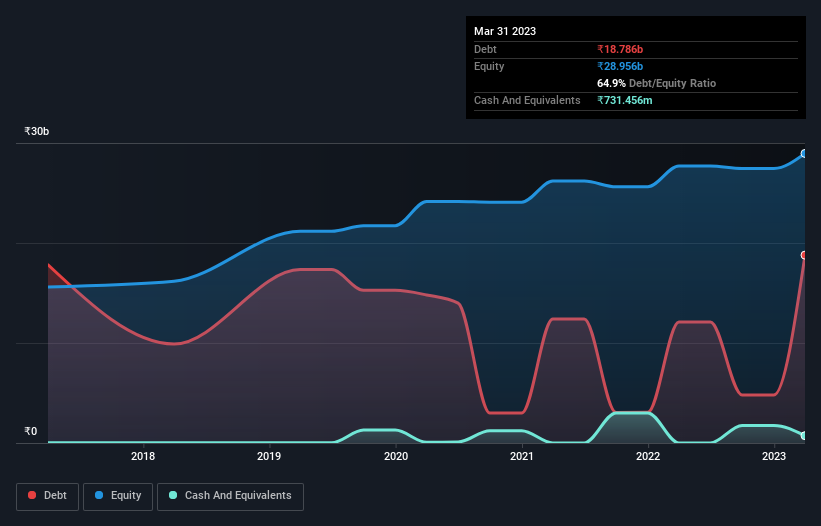Here's Why Balrampur Chini Mills (NSE:BALRAMCHIN) Has A Meaningful Debt Burden

The external fund manager backed by Berkshire Hathaway's Charlie Munger, Li Lu, makes no bones about it when he says 'The biggest investment risk is not the volatility of prices, but whether you will suffer a permanent loss of capital.' So it might be obvious that you need to consider debt, when you think about how risky any given stock is, because too much debt can sink a company. As with many other companies Balrampur Chini Mills Limited (NSE:BALRAMCHIN) makes use of debt. But is this debt a concern to shareholders?
When Is Debt A Problem?
Debt assists a business until the business has trouble paying it off, either with new capital or with free cash flow. In the worst case scenario, a company can go bankrupt if it cannot pay its creditors. However, a more usual (but still expensive) situation is where a company must dilute shareholders at a cheap share price simply to get debt under control. Having said that, the most common situation is where a company manages its debt reasonably well - and to its own advantage. When we think about a company's use of debt, we first look at cash and debt together.
See our latest analysis for Balrampur Chini Mills
What Is Balrampur Chini Mills's Debt?
As you can see below, at the end of March 2023, Balrampur Chini Mills had ₹18.8b of debt, up from ₹12.1b a year ago. Click the image for more detail. However, it does have ₹731.5m in cash offsetting this, leading to net debt of about ₹18.1b.

How Strong Is Balrampur Chini Mills' Balance Sheet?
We can see from the most recent balance sheet that Balrampur Chini Mills had liabilities of ₹19.6b falling due within a year, and liabilities of ₹5.69b due beyond that. Offsetting this, it had ₹731.5m in cash and ₹1.25b in receivables that were due within 12 months. So its liabilities outweigh the sum of its cash and (near-term) receivables by ₹23.3b.
Balrampur Chini Mills has a market capitalization of ₹78.0b, so it could very likely raise cash to ameliorate its balance sheet, if the need arose. But we definitely want to keep our eyes open to indications that its debt is bringing too much risk.
We measure a company's debt load relative to its earnings power by looking at its net debt divided by its earnings before interest, tax, depreciation, and amortization (EBITDA) and by calculating how easily its earnings before interest and tax (EBIT) cover its interest expense (interest cover). This way, we consider both the absolute quantum of the debt, as well as the interest rates paid on it.
Balrampur Chini Mills has net debt to EBITDA of 3.1 suggesting it uses a fair bit of leverage to boost returns. On the plus side, its EBIT was 9.2 times its interest expense, and its net debt to EBITDA, was quite high, at 3.1. Shareholders should be aware that Balrampur Chini Mills's EBIT was down 25% last year. If that earnings trend continues then paying off its debt will be about as easy as herding cats on to a roller coaster. The balance sheet is clearly the area to focus on when you are analysing debt. But it is Balrampur Chini Mills's earnings that will influence how the balance sheet holds up in the future. So if you're keen to discover more about its earnings, it might be worth checking out this graph of its long term earnings trend.
Finally, a company can only pay off debt with cold hard cash, not accounting profits. So it's worth checking how much of that EBIT is backed by free cash flow. Looking at the most recent three years, Balrampur Chini Mills recorded free cash flow of 27% of its EBIT, which is weaker than we'd expect. That's not great, when it comes to paying down debt.
Our View
We'd go so far as to say Balrampur Chini Mills's EBIT growth rate was disappointing. But on the bright side, its interest cover is a good sign, and makes us more optimistic. Looking at the balance sheet and taking into account all these factors, we do believe that debt is making Balrampur Chini Mills stock a bit risky. Some people like that sort of risk, but we're mindful of the potential pitfalls, so we'd probably prefer it carry less debt. The balance sheet is clearly the area to focus on when you are analysing debt. But ultimately, every company can contain risks that exist outside of the balance sheet. For example, we've discovered 4 warning signs for Balrampur Chini Mills (1 doesn't sit too well with us!) that you should be aware of before investing here.
If, after all that, you're more interested in a fast growing company with a rock-solid balance sheet, then check out our list of net cash growth stocks without delay.
Valuation is complex, but we're here to simplify it.
Discover if Balrampur Chini Mills might be undervalued or overvalued with our detailed analysis, featuring fair value estimates, potential risks, dividends, insider trades, and its financial condition.
Access Free AnalysisHave feedback on this article? Concerned about the content? Get in touch with us directly. Alternatively, email editorial-team (at) simplywallst.com.
This article by Simply Wall St is general in nature. We provide commentary based on historical data and analyst forecasts only using an unbiased methodology and our articles are not intended to be financial advice. It does not constitute a recommendation to buy or sell any stock, and does not take account of your objectives, or your financial situation. We aim to bring you long-term focused analysis driven by fundamental data. Note that our analysis may not factor in the latest price-sensitive company announcements or qualitative material. Simply Wall St has no position in any stocks mentioned.
About NSEI:BALRAMCHIN
Balrampur Chini Mills
Engages in the manufacture and sale of sugar in India.
Flawless balance sheet and undervalued.
Market Insights
Community Narratives



